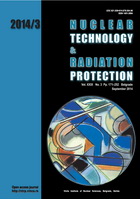
PATIENT DOSE MEASUREMENT AND DOSE REDUCTION IN CHEST RADIOGRAPHY

Vol.
XXIX, No. 3, Pp. 171-252
September 2014
UDC 621.039+614.876:504.06
ISSN 1451-3994
Pages: 220-225
Authors: Aleksandra A. MilatoviŠ, Vesna M. SpasiŠ JokiŠ, and Slobodan I. JovanoviŠ
Abstract
Investigations presented in this paper represent the first estimation of patient doses in chest radiography in Montenegro. In the initial stage of our study, we measured the entrance surface air kerma and kerma area product for chest radiography in five major health institutions in the country. A total of 214 patients were observed. We reported the mean value, minimum and third quartile values, as well as maximum values of surface air kerma and kerma area product of patient doses. In the second stage, the possibilities for dose reduction were investigated. Mean kerma area product values were 0.8 ± 0.5 Gycm2 for the posterior-anterior projection and 1.6 ± 0.9 Gycm2 for the lateral projection. The max/min ratio for the entrance surface air kerma was found to be 53 for the posterior-anterior projection and 88 for the lateral projection. Comparing the results obtained in Montenegro with results from other countries, we concluded that patient doses in our medical centres are significantly higher. Changes in exposure parameters and increased filtration contributed to a dose reduction of up to 36% for posterior-anterior chest examinations. The variability of the estimated dose values points to a significant space for dose reduction throughout the process of radiological practice optimisation.
Key words: chest radiography, X-rays, radiation dose, entrance surface air kerma
FULL PAPER IN PDF FORMAT (219 KB)